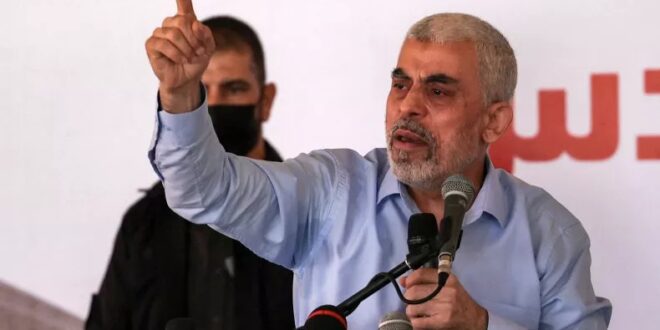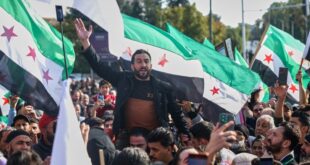Israel has announced the killing of Yahya Sinwar, the leader of Hamas and mastermind of the October 7, 2023, attack that has since plunged the Middle East into an escalating conflict between Israel and Iran.
Israeli Prime Minister Benjamin Netanyahu said Thursday his nation has “settled its account” with Sinwar who evaded capture and death for more than a year after overseeing what Netanyahu referred to as “the worst massacre in the history of our people since the Holocaust.”
The remarks followed a joint statement issued by the Israel Defense Forces (IDF) and Israel Security Agency (ISA), better known as Shin Bet, that confirmed Sinwar’s demise in an Israeli operation conducted by the 828th Brigade under the IDF’s Southern Command.
“The IDF and ISA confirm that after a year-long pursuit, yesterday (Wednesday), October 16, 2024, IDF soldiers from the Southern Command eliminated Yahya Sinwar, the leader of the Hamas terrorist organization, in an operation in the southern Gaza Strip,” according to the statement shared with Newsweek.
“Yahya Sinwar planned and executed the October 7th Massacre, promoted his murderous ideology both before and during the war, and was responsible for the murder and abduction of many Israelis,” the statement added.
Earlier, the IDF and ISA had said they were “checking the possibility” that Sinwar was among three militants reportedly killed in the operation. After confirming his death, the IDF shared drone footage of what was purported to show the Hamas chief sitting in a chair, his face covered in a scarf just moments before his death.
“Yahya Sinwar was eliminated after hiding for the past year behind the civilian population of Gaza, both above and below ground in Hamas tunnels in the Gaza Strip,” the IDF and ISA said. “The dozens of operations carried out by the IDF and the ISA over the last year, and in recent weeks in the area where he was eliminated, restricted Yahya Sinwar’s operational movement as he was pursued by the forces and led to his elimination.”
Reports suggested that DNA testing was used to verify Sinwar’s identity. Graphic photographs also circulated online purporting to show his body, though these could not be independently verified.
Hamas has yet to officially comment on the reports, though other allied Palestinian factions in Gaza such as the Democratic Front for the Liberation of Palestine and Popular Front of the Liberation of Palestine, as well as their ally, Iran, have already begun commemorating the fallen leader. Newsweek has reached out to Hamas for comment.
Uncertain Impact
Sinwar’s death has the potential to represent a significant shift in the conflict at a time when negotiations toward a ceasefire have repeatedly failed and casualties continue to mount in the longest and deadliest war in Gaza to date, though its influence ultimately remains uncertain.
The conflict began when Hamas launched an unprecedented attack against Israel on October 7, 2023, in what came to be known to the group as “the Battle of Al-Aqsa Flood” after the revered holy site in the disputed city of Jerusalem. The following day, Netanyahu declared “Operation Swords of Iron,” a large-scale war against the group in its Gaza stronghold.
Since then, Hamas and Israel have repeatedly blamed one another for hindering progress toward realizing a three-phase truce outlined by U.S. President Joe Biden in May.
In a statement published Thursday, Biden welcomed news of Sinwar’s death and said he had directed U.S. Special Operations and intelligence personnel “to work side-by-side with their Israeli counterparts to help locate and track Sinwar and other Hamas leaders hiding in Gaza.”
He said he would soon meet with Netanyahu and other Israeli officials “to congratulate them, to discuss the pathway for bringing the hostages home to their families, and for ending this war once and for all, which has caused so much devastation to innocent people.”
Netanyahu, meanwhile, has vowed to continue the war until key objectives were met including the total elimination of Hamas as military and political entity, the rendering of Gaza incapable of posing a threat to Israel in the future and the return of around 100 hostages that remain in the group’s captivity since the October 7 attack that also killed around 1,200 people, according to Israeli officials.
The Gaza-based Palestinian Health Ministry has estimated that more than 42,400 people have been killed in the ensuing war against the Hamas-held territory.
Sinwar’s death provides another symbolic victory for Netanyahu, who has promised to punish all those involved in the attack last year. In his remarks on Thursday, the Israeli premier said that those in Gaza holding weapons and hostages would be allowed to live and leave if they laid down their arms and released the remaining captives.
However, Hamas officials have traditionally downplayed the impact of losing senior leaders on an organization that has dealt with much of its top officials having been killed by Israel over the decades.
Speaking to Newsweek in February, Hamas Political Bureau member and spokesperson Basem Naim said that “it is true that the leaders are an essential element in the battle and achieving victory over the enemy,” but “this conflict is not between Hamas and Israel, but between the Palestinians and Israel, and with legitimate national goals, and therefore assassinating any of the leaders will not stop the battle and will not end the conflict.”
“Assassinations may temporarily affect the course of the battle,” Naim said at the time, “but there are a number of alternative leaders capable of managing the battle with the same efficiency.”
Since then, however, much of Hamas’ leading figures appear to have been killed. Sinwar’s predecessor, former Political Bureau chief Ismail Haniyeh was assassinated in the Iranian capital of Tehran in July, while the group’s Al-Qassam Brigades military wing commander Mohammed Deif and his deputy Marwan Issa were declared dead by the IDF in July and March, respectively.
Hamas has yet to officially acknowledge the deaths of Deif and Issa, while Israel has neither confirmed nor denied its responsibility for Haniyeh’s death in Tehran.
Naim again shared with Newsweek his thoughts on how Hamas and other groups may respond to the loss of top leaders last month in the wake of the Israeli airstrike that killed longtime Hezbollah Secretary-General Hassan Nasrallah in Beirut.
“Is Israel’s problem with armed groups with limited agendas that can be eliminated by killing their leaders, or with peoples who have rights that they have been striving to achieve for decades and have not stopped or surrendered despite the killing of many leaders?” Naim asked at the time. “Has any resistance group disappeared after the assassination of the leaders?”
“They have all become stronger and more widespread,” the former Palestinian Health Minister added. “Israel may achieve tactical achievements in its military operations, but it loses the strategic battle, or as we say in the world of medicine, the surgery succeeded, but the patient died.”
Sinwar’s Rise and Fall
Sinwar, also known as Abu Ibrahim, has long been identified as one of the chief architects of the attack against Israel last October, placing him high on the IDF’s kill list.
Born in the southern Gaza city of Khan Younis in 1962 to refugees of the 1948 Arab-Israeli War that set the stage for decades of conflict to come, Sinwar established himself as key figure in the newly formed Hamas in the 1980s, going on to lead the Al-Qassam Brigades’ Internal Security Force, also known as Al-Majd.
He was arrested by Israeli forces in 1988 at a time when Gaza was still under Israeli occupation. He would be freed in 2011 alongside over 1,000 other prisoners in exchange for the freedom of IDF Corporal Gilad Shalit, who had been abducted five years earlier by armed Palestinian factions operating out of Gaza.
Sinwar returned to a Gaza now firmly under Hamas’ control after the group seized the territory in 2007 amid post-election clashes with the rival Palestinian Fatah faction following the IDF’s 2005 withdrawal. Sinwar continued to rise up the ranks, being named the group’s leader in Gaza in 2017, a position he held until being promoted to Political Bureau chief upon Haniyeh’s death in July.
After surviving an Israeli airstrike that reportedly targeted him during a previous conflict between Israel and Hamas in May 2021, Sinwar declared during a press conference that “the greatest gift the enemy and the occupation can give me is assassinating me.”
“I would prefer to die by martyrdom,” Sinwar said at the time, “by F-16s or by missiles, than to die of corona, or a stroke, or a heart attack.”
An Escalating Conflict
While Israel has made strides in its war against Hamas in Gaza, the IDF also faces a broader battle with Iran and its Axis of Resistance coalition that has increasingly entered the fray since last October.
Days after killing Nasrallah last month amid intensifying cross-border clashes between the IDF and Hezbollah, Israel launched its first ground offensive into Lebanon since 2006. The operation came in line with an additional wartime goal set by Netanyahu to restore security on the northern front and return tens of thousands of Israelis displaced by the fighting.
Israel has also faced a growing tempo of missile and drone attacks from the Islamic Resistance in Iraq and Yemen’s Ansar Allah, also known as the Houthi movement.
Iran itself has also conducted two direct missile strikes against Israel throughout the course of the war, the latest most intensive round coming last month as retaliation for the deaths of Haniyeh, Nasrallah and Iranian Islamic Revolutionary Guard Corps (IRGC) General Abbas Nilforushan who was killed alongside the Hezbollah chief in Beirut. Israel has vowed to respond, raising concerns of further escalation.
Speaking at Nilforushan’s funeral on Thursday, IRGC Major General Hossein Salami declared that the most recent Iranian strike on Israel, called “Operation True Promise II,” served merely as a “warning” and that any further attacks by Israel would be met with even harsher measures.
“We carried out Operation True Promise to make your calculations more precise,” Salami said. “You must understand that when you attack our citizens, our figures, or our interests, we will retaliate.”
Iranian officials also later reacted to news of Sinwar’s death, contrasting his final moments with those of late Iraqi President Saddam Hussein, who the Iranian Mission to the United Nations described as pleading for his life upon being captured by U.S. forces in his underground hideout in December 2003.
“Those who regarded Saddam as their model of resistance eventually collapsed,” the Iranian Mission said in a statement shared with Newsweek and published to X, formerly Twitter. “However, when Muslims look up to Martyr Sinwar standing on the battlefield—in combat attire and out in the open, not in a hideout, facing the enemy—the spirit of resistance will be strengthened.”
“He will become a model for the youth and children who will carry forward his path toward the liberation of Palestine,” the statement added. “As long as occupation and aggression exist, resistance will endure, for the martyr remains alive and a source of inspiration.”
 Eurasia Press & News
Eurasia Press & News




